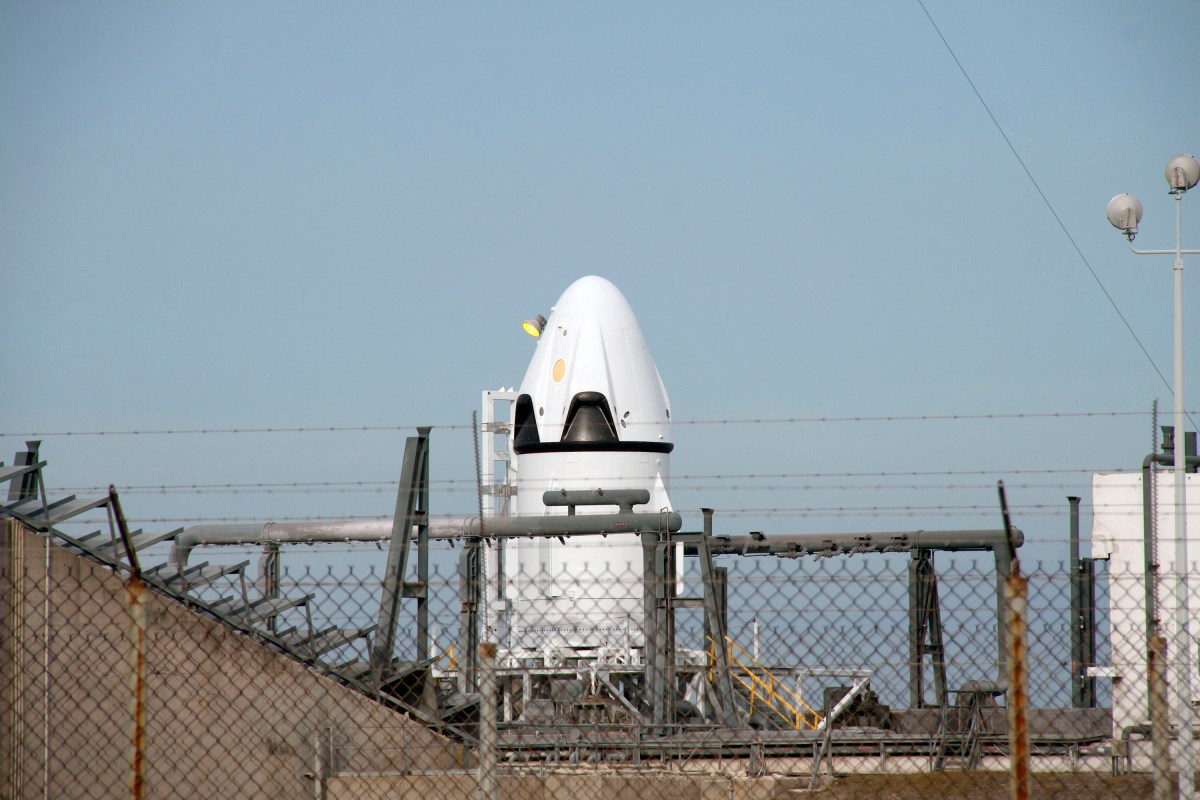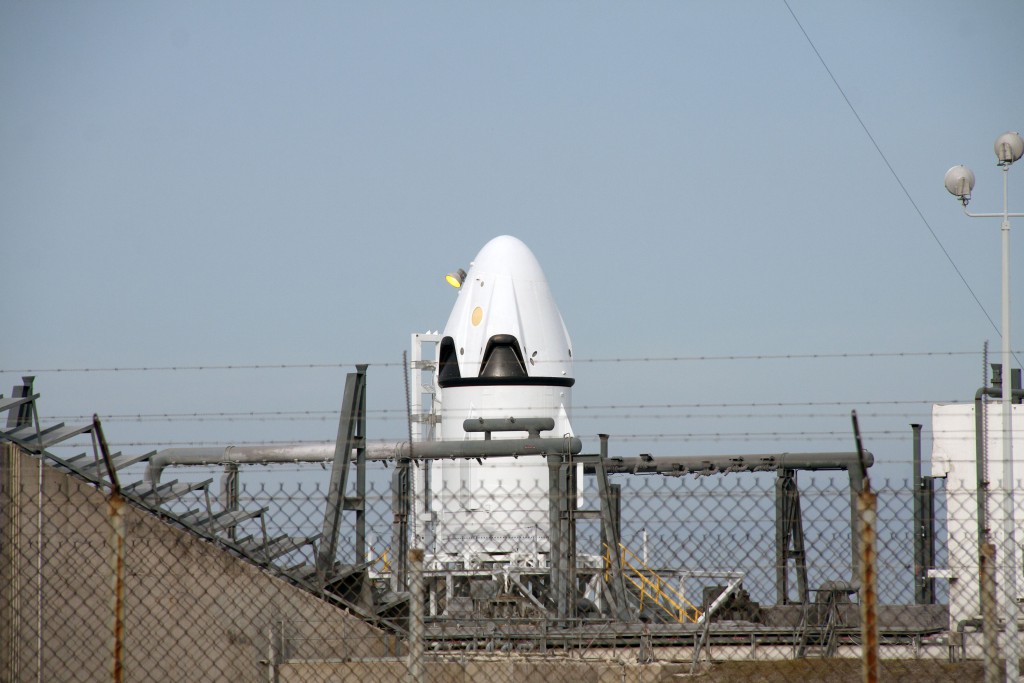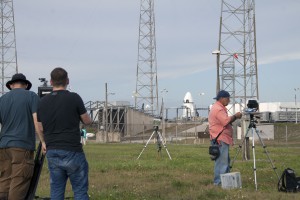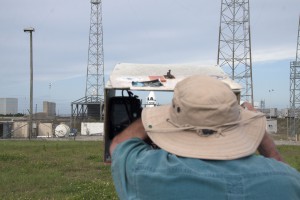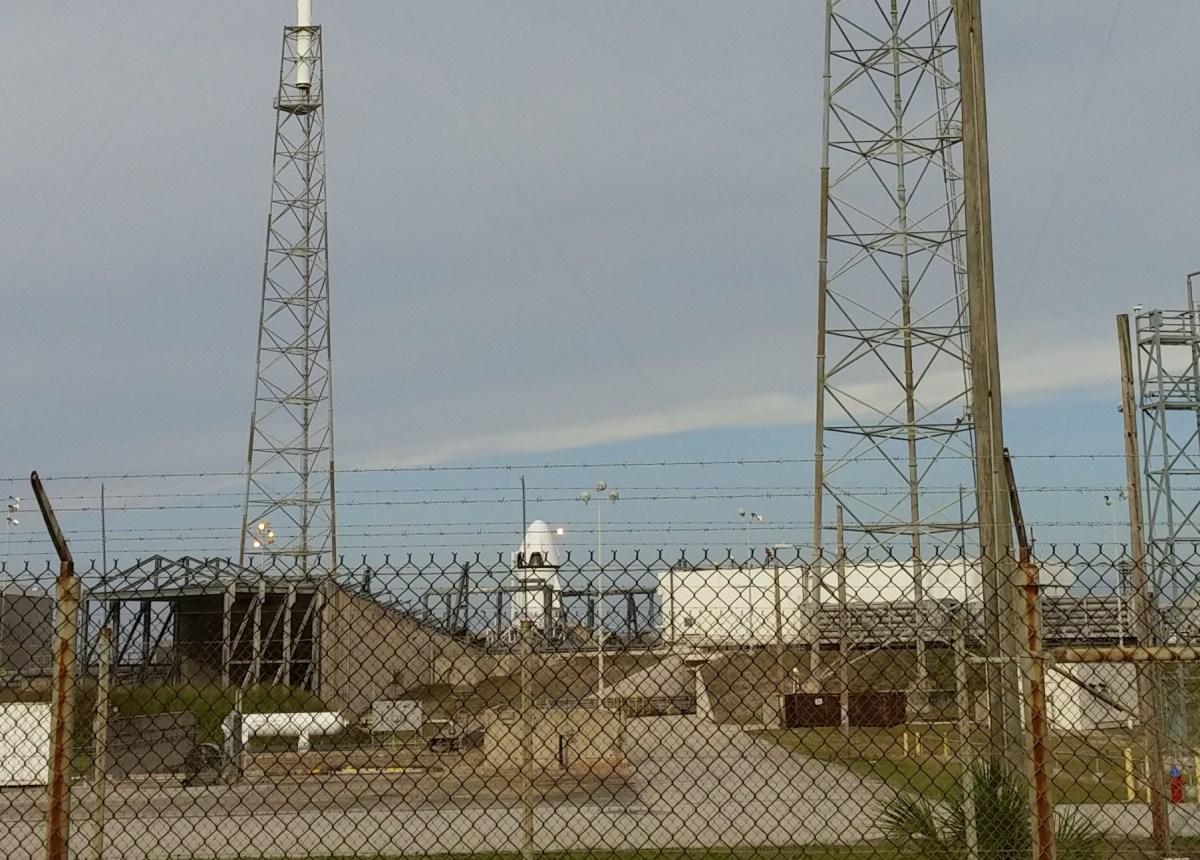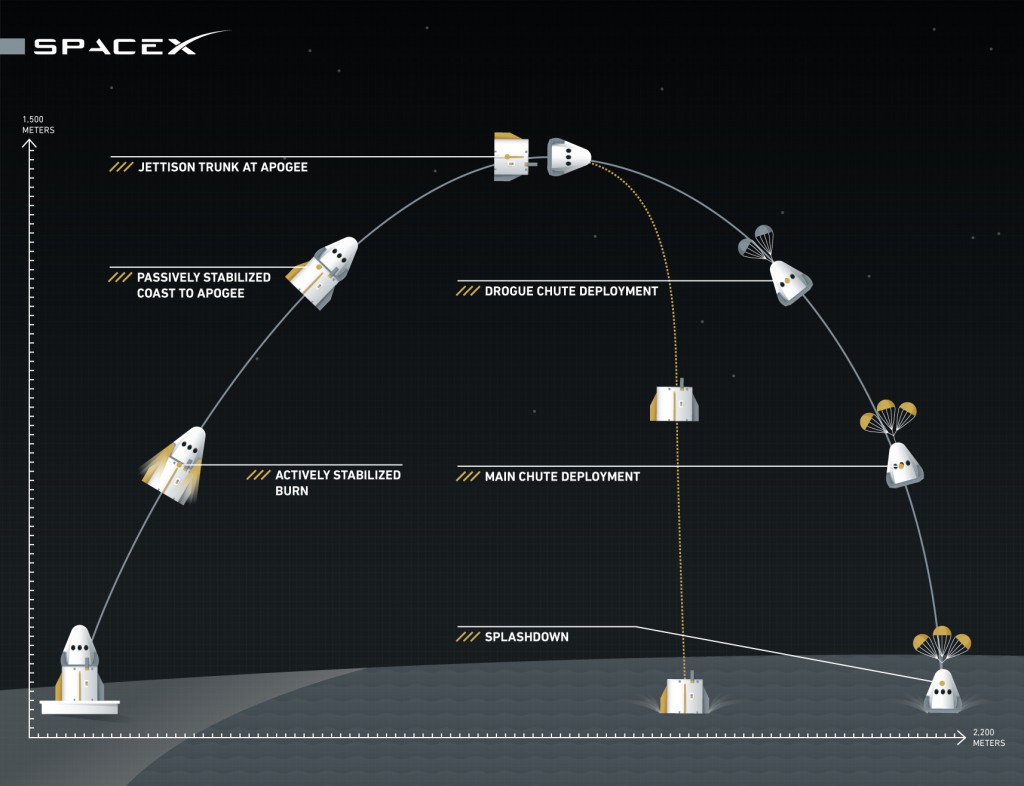The countdown will move into the terminal or final phase at T-10 minutes. Weather remains go.
Month: May 2015
T-15 Minutes and Counting
Today’s countdown continues on schedule.
SpaceX Uncrewed Flight Today Will Test Abort System for Crew Dragon
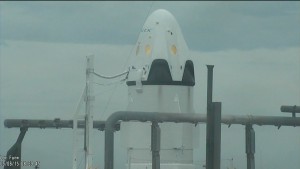 A test version of the SpaceX Crew Dragon stands ready for today’s flight test that will simulate an emergency abort from the launch pad. The SpaceX team is reporting that the vehicle, ground systems and weather are cooperating for a T-0 at 9 a.m. EDT. A go/no-go poll to enter the terminal count will be conducted at T-13 minutes.
A test version of the SpaceX Crew Dragon stands ready for today’s flight test that will simulate an emergency abort from the launch pad. The SpaceX team is reporting that the vehicle, ground systems and weather are cooperating for a T-0 at 9 a.m. EDT. A go/no-go poll to enter the terminal count will be conducted at T-13 minutes.
The SuperDraco engines integrated into the side of the spacecraft will ignite at the pad and burn for about six seconds to lift the Dragon and its trunk about a mile above Cape Canaveral Air Force Station and the Atlantic Ocean. Soon after the propellant is exhausted, the spacecraft will deploy drogue chutes then three full-size parachutes. It will then splash down in the Atlantic where it will be recovered by two fast boats and a barge.
The Crew Dragon’s four “jet packs” house a total of eight SuperDrago engines around the vehicle. Each one provides about 15,000 pounds of thrust by burning hypergolic propellants monomethylhydrazine and nitrogen tetroxide. The two chemicals are called hypergolic because they ignite instantly when they come in contact with each other. Together, the eight thrusters will produce more than 120,000 pounds of thrust at ignition.
This is the first such test for the SpaceX spacecraft, which is being designed and tested in partnership with NASA’s Commercial Crew Program, and the first test of its kind from the Space Coast. The Crew Dragon’s arrangement of thrusters around the midsection of the spacecraft is a departure from previous human space exploration systems because the thrusters are integrated into the spacecraft, pushing the vehicle to safety and offering escape capability all the way to orbit. Previous spacecraft, such as Mercury and Apollo, used a small rocket on a tower mounted atop the capsules to pull the crew away from danger, but after a certain altitude, the tower system could no longer be used.
Countdown Proceeding for Test Flight
T-25 minutes and counting this morning at Space Launch Complex 40 as SpaceX preps for the Pad Abort Test for its Crew Dragon spacecraft. Watch live on NASA TV now.
Test Day for Crew Dragon
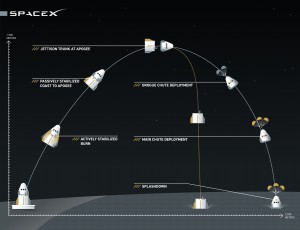 Forecasters from the U.S. Air Force 45th Weather Squadron continue to predict a 70 percent chance of favorable weather for the SpaceX Pad Abort Test. The test is planned for 9 a.m. EDT from Space Launch Complex 40 on Cape Canaveral Air Force Station in Florida. SpaceX Launch Conductor Erin Beck informed the test team that there are no weather constraints at this time.
Forecasters from the U.S. Air Force 45th Weather Squadron continue to predict a 70 percent chance of favorable weather for the SpaceX Pad Abort Test. The test is planned for 9 a.m. EDT from Space Launch Complex 40 on Cape Canaveral Air Force Station in Florida. SpaceX Launch Conductor Erin Beck informed the test team that there are no weather constraints at this time.
The SpaceX pad abort test team began communications checks at about 6:40 a.m. EDT. Teams are monitoring the weather and will receive an official brief from Launch Weather Officer Mike McAleenan a little later in the countdown. The pad perimeter at Space Launch Complex 40 is now clear of all personnel.
NASA will provide updates about the test on the Commercial Crew Blog and air the test live on NASA Television. The test will see a Crew Dragon and trunk – together about 20 feet tall – fly on the power of eight SuperDraco engines. There will be no crew members aboard the spacecraft during the test, which will simulate an emergency escape from the launch pad in the unlikely case of booster failing at liftoff or other scenario that would threaten astronauts inside the spacecraft.
SpaceX Pad Abort Test Window Begins Two Hours Later at 9 a.m. EDT
SpaceX reported this evening that it has moved the start of its Pad Abort Test window two hours to 9 a.m. EDT on Wednesday, May 6, from Space Launch Complex 40 on Cape Canaveral Air Force Station in Florida.

The test will see a Crew Dragon and trunk – together about 20 feet tall – fly on the power of eight SuperDraco engines. There will be no crew members aboard the spacecraft during the test, which will simulate an emergency escape from the launch pad in the unlikely case of booster failing at liftoff or other scenario that would threaten astronauts inside the spacecraft.
NASA will provide updates about the test right here on the Commercial Crew Blog and air the test live on NASA Television. To join the online conversation about the SpaceX Pad Abort Test, follow the hashtag #LaunchAmerica.
Setting the Scene at SLC-40
Reporters and photographers went out to Space Launch Complex 40 at Cape Canaveral Air Force Station this morning to set up equipment ahead of tomorrow’s pad abort test by the SpaceX Crew Dragon. The Crew Dragon is on a platform above the launch pad. For more photos throughout the test, go to our Flickr album.
Forecast Remains 70 Percent ‘Go’ for Test on Wednesday
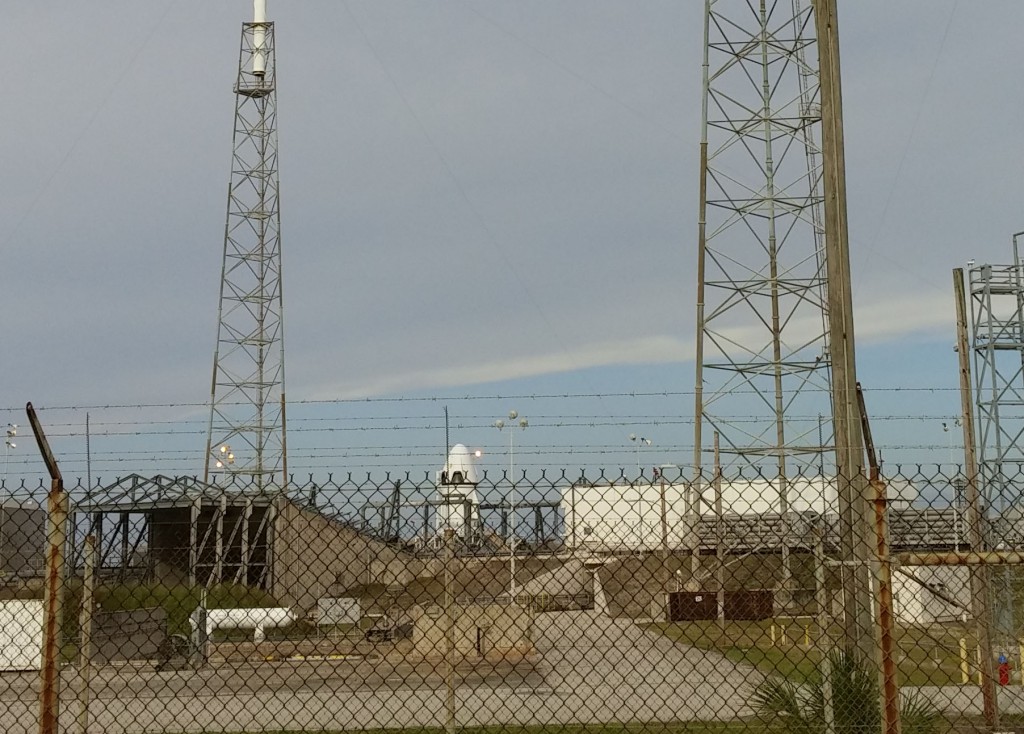 One day prior to the SpaceX Pad Abort Test, forecasters from the U.S. Air Force 45th Weather Squadron continue to predict a 70 percent chance of favorable weather. The test is scheduled for Wednesday, May 6, at Space Launch Complex 40 on Cape Canaveral Air Force Station in Florida.
One day prior to the SpaceX Pad Abort Test, forecasters from the U.S. Air Force 45th Weather Squadron continue to predict a 70 percent chance of favorable weather. The test is scheduled for Wednesday, May 6, at Space Launch Complex 40 on Cape Canaveral Air Force Station in Florida.
The detailed weather rundown from the 45th Space Wing: Easterly winds remain strong across Central Florida today, with morning showers along the Space Coast. Also, models have come into better agreement on what will happen to the area of unsettled weather around South Florida and the Bahamas. The area will likely spawn a low pressure system late today or early Wednesday that will drift northward as it slowly intensifies. The exact track is still somewhat up in the air, but the model trends show for a more eastward development. This track will take the system away from the Spaceport, which will result in acceptable wind speeds for the test. Maximum winds to 5,000 feet will be ENE at 20 knots and this is the primary abort weather concern.
On Thursday, winds will continue to weaken as the area of low pressure continues to move northeast. Maximum winds to 5,000 feet will be northeasterly at 15 knots.
What Will SpaceX’s Pad Abort Test Look Like?
During a pad abort test preview last week, engineers with NASA and SpaceX told us what they hope to learn from the demonstration of the company’s escape system. Below are a few more details about the sequence of events and what the test will look like if you’re watching here along Florida’s Space Coast or live on NASA TV on Wednesday, May 6.
The biggest takeaway is that this test will be quick! And that’s the point – SpaceX wants to demonstrate its ability to carry crew members away from a dangerous situation on the launch pad in a hurry. For context, Crew Dragon will accelerate from 0 to nearly 100 mph in one second. The entire test is less than two minutes long, with Dragon traveling over one mile in the first 20 seconds alone.
T-0: The eight SuperDracos ignite simultaneously and reach maximum thrust, propelling the spacecraft off the pad.
T+0.5s: After half a second of vertical flight, Crew Dragon pitches toward the ocean and continues its controlled burn. The SuperDraco engines throttle to control the trajectory based on real-time measurements from the vehicle’s sensors.
T+5s: The abort burn is terminated once all propellant is consumed and Dragon coasts for just over 15 seconds to its highest point about 1500 meters (.93 mi) above the launch pad.
T+21s: The trunk is jettisoned and the spacecraft begins a slow rotation with its heat shield pointed toward the ground again.
T+25s: Small parachutes, called drogues, are deployed first during a 4-6 second window following trunk separation.
T+35s: Once the drogue parachutes stabilize the vehicle, three main parachutes deploy and further slow the spacecraft before splashdown.
T+107s: Dragon splashes down in the Atlantic Ocean about 2,200 meters (1.4 miles) downrange of the launch pad.
SpaceX released images of the spacecraft and a “5 Things to Know” about the pad abort test on its website, which you can read here.
Source Evaluation Board Earns Stellar Team Award
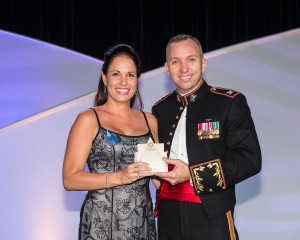 The Rotary National Award for Space Achievement Foundation presented a prestigious Stellar Team Award to NASA’s Commercial Crew Transportation Capability source evaluation board in recognition of the innovative strategies, careful work, thorough preparation and long hours spent evaluating bids for America’s next crew transportation systems.
The Rotary National Award for Space Achievement Foundation presented a prestigious Stellar Team Award to NASA’s Commercial Crew Transportation Capability source evaluation board in recognition of the innovative strategies, careful work, thorough preparation and long hours spent evaluating bids for America’s next crew transportation systems.
Maria Collura accepted the award from astronaut Randy Bresnik on behalf of the team during a black-tie gala in Houston on April 24. The foundation issues awards annually to note the work of the “unsung heroes” in the space field. “This award is truly about the amazing team effort,” Collura said. “I was just blessed enough to lead the team and accept their award.”

